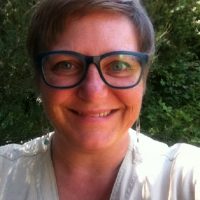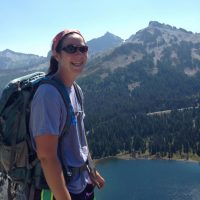Staff Spotlight: Lisa Sanphillippo

Meet Lisa Dora Sanphillippo! Lisa is the School Fieldtrips Coordinator for UW Botanic Gardens.
She lived in L.A. until she was 8 years old. Her mom “got a little freaked out” by the big city, big crime and smog so she moved them to a tiny town in Idaho called Kamiah (population 2500). The family lived in the middle of a National Forest and the Clearwater River.
A Wind in the Willows (and Cedars, Firs, Maples…)
How some trees react to high winds.
1) Pseudotsuga menziesii Douglas Fir
The detritus lying on the ground following a wind event in the Pacific Northwest provides ample evidence of how P. menziesii defends itself against wind.
The wood of P. menziesii is brittle and can snap. When a strong wind acts on a Douglas Fir, the tree sacrifices small pieces of foliage to shed the wind’s energy.
Art Exhibit: Now You See It! The Slime Mold Revelation
What do evolution and the Emperor of Japan have to do with art about slime molds? Now You See It! The Slime Mold Revelation reveals the stories behind four centuries of artistic devotion to these otherworldly organisms. Exhibit runs Sep. 15 – Oct 30.
Read moreA Gift of Seeds: Two New Colorful Crop Varieties for the UW Farm
~Rae Russell
Last week, I was part of a lucky group of UW Farm interns and volunteers that visited Littlefield Farm; an organic farm in Arlington WA where all of the equipment runs on traditional horse power. Farmer Ryan Foxley gave us a glimpse into a method of small-scale, resilient farming that offers a compelling solution to today’s current fuel concerns by relying entirely on the use of draught horses to work the soil and harvest crops.
Student Spotlight: Anna Carragee

All Posts
Meet Anna Louise Carragee. Anna is a Master of Environmental Horticulture student in the University of Washington’s School of Environmental and Forest Sciences, and she will start her second year this fall. She has 3 part-time positions at UW Botanic Gardens: Greenhouse Assistant, Nursery Manager for the Society for Ecological Restoration – UW Chapter’s Native Plant Nursery (housed at the Center for Urban Horticulture), and a short-term position to support the City’s Seattle reLeaf program to help re-inventory and evaluate the health of street trees planted with the Trees for Neighborhoods project.
The UW Farm Has A Produce Stand!
Stop by UW Farm’s produce stand this summer and treat yourself to fresh, seasonal, sustainably sourced produce grown just two miles away! UW Farm is proud to support sustainable agriculture and works hard to help create a community-driven local food system right here in Seattle. Come join us!
We meet Fridays from 4pm-7pm, in the Fisheries Supply parking lot at 1900 N.
Botanical Sketching, and I Need a Pen
Our first offering of Botanical Sketching in Ink and Watercolor wraps up this week. This popular series will be offered again this fall on Monday mornings, starting October 5. Learn more and register.
Blog post by Saffron Hefta-Gaub, summer communications volunteer
August 3, 2015
Today I showed up at the UW Botanic Gardens right at 10:00 am, to sit in on the first Botanical Sketching and Watercolor class.
Fall Family Fun!
Visit the UW Botanic Gardens this fall for to see some colorful leaves, and participate in some fun activities for families with kids 2-12 years old!
Read moreExperimenting with Fertilization Methods at the UW Farm: Yunpeng Feng
Yunpeng worked with his faculty advisor, Elizabeth Wheat, to design and implement an experiment on the farm using different fertilizers. Read more!
Goal: The purpose of this experiment is to examine whether using a combination of three organic fertilizers, kelp meal, blood meal, and crab meal is more effective than only using a single dose of Bio·Bloom™.
Subject: The plant we chose for this particular experiment is kale.
Student Spotlight: Regina Wandler

Regina Wandler is a graduate student in the Master of Environmental Horticulture program, within the University of Washington’s School of Environmental and Forest Sciences. For her masters project, she is working with UW Botanic Gardens to develop a continuing education program for restoration professionals in the Pacific Northwest.
Regina grew up in Everett, WA (pretty local!) and went to UW for her undergraduate education as well.